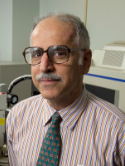Solution conformation of the (-)-trans-anti-5-methylchrysene-dG adduct opposite dC in a DNA duplex: DNA bending associated with wedging of the methyl group of 5-methylchrysene to the 3′-side of the modification site Journal Article
| Authors: | Cosman, M.; Xu, R.; Hingerty, B. E.; Amin, S.; Harvey, R. G.; Geacintov, N. E.; Broyde, S.; Patel, D. J. |
| Article Title: | Solution conformation of the (-)-trans-anti-5-methylchrysene-dG adduct opposite dC in a DNA duplex: DNA bending associated with wedging of the methyl group of 5-methylchrysene to the 3′-side of the modification site |
| Abstract: | This paper reports on NMR molecular mechanics structural studies of the (-)-trans-anti-[MC]dG adduct positioned opposite dC in the sequence context of the d(C1-C2-A3-T4-C5-[MC]G6-C7-T8-A9-C10-C11)•d(G 12-G13-T14-A15-G16-C17-G18-A19-T20-G21-G22) duplex [designated (-)-transanti-[MC]dG•C 11-mer duplex]. This adduct is derived from the trans addition at C4 of (-)-anti-1 (S),2(R)-dihydroxy-3(R),4(5)-epoxy-1,2,3,4-tetrahydro-5-methylchrysene [(-)-anti-5-MeCDE] to the N2 position of dG6 in this duplex sequence. The 5-methyl group is located adjacent to the MC(C4) binding site, with these groups juxtaposed in a sterically crowded bay region in the adduct duplex. The 5-methylchrysenyl and the nucleic acid exchangeable and nonexchangeable protons were assigned following analysis of two-dimensional NMR data sets in H2O and D2O buffer solution. The solution structure of the-ranj-anri-[MC]dG•dC 11-mer duplex has been determined by incorporating DNA-DNA and carcinogen-DNA proton-proton distances defined by lower and upper bounds deduced from NOESY data sets as restraints in molecular mechanics computations in torsion angle space. The results establish that the [MC]dG6•dC17 base pair and flanking dC5•dG18 and dC7•dG16 base pairs retain Watson-Crick alignments upon adduct formation. The aromatic chrysenyl ring is positioned in the minor groove of a right-handed B-DNA helix and stacks predominantly over the sugar of the dC17 residue across from it on the unmodified complementary strand. The chrysenyl ring points toward the 3'-end of the modified strand with its 5-methyl group inserting between the modified [MC]dG6•dC17 and dC7•dG16 base pairs. The adduct duplex bends by ~47° as a result of the wedged insertion of the 5-methyl group from the minor groove face of the duplex. The solution structure of the (-)-frans-anf/-[MC]dG•dC 11-mer duplex is compared with that of the corresponding-trans-anti-[BP]dG•dC 11-mer [De los Santos et al. (1992) Biochemistry 31, 5245-5252] in which the [BP]dG adduct is derived from the binding of (-)-anti-BPDE [7(S),8(R)-dihydroxy-9(R), 10(S)-epoxy-7,8,9,10-tetrahydrobenzo[a]pyrene] to the N2 position of dG in the same DNA sequence context. Although the solution structures of the (-)-trans-anti stereoisomers of 5-methylchrysenyl-dG and benzo[ti]pyrenyl-dG adducts opposite dC exhibit many features in common with each other, the [MC]-dG adduct which contains a bay region methyl group bends the DNA helix to a greater extent than in the corresponding [BP]dG adduct, which lacks a bay region methyl group. Carcinogen-induced bending effects may be important factors in the expression of the mutagenic potential of these [MC]dG lesions. Because of the stabilities of these lesions, site-directed mutagenesis studies are now feasible which should lead to new insights into the relationships between adduct structure, DNA structural distortions, and mutagenic specificity and activity. © 1995, American Chemical Society. All rights reserved. |
| Keywords: | sequence analysis; dna; double stranded dna; dna modification; carcinogenicity; deoxyguanosine; base pairing; dna adduct; computer simulation; models, molecular; solutions; molecular structure; molecular interaction; site directed mutagenesis; nuclear magnetic resonance; molecular conformation; curved dna; priority journal; article; support, non-u.s. gov't; support, u.s. gov't, p.h.s.; support, u.s. gov't, non-p.h.s.; chrysene derivative; chrysenes; aromatic hydrocarbon |
| Journal Title: | Biochemistry |
| Volume: | 34 |
| Issue: | 18 |
| ISSN: | 0006-2960 |
| Publisher: | American Chemical Society |
| Date Published: | 1995-05-09 |
| Start Page: | 6247 |
| End Page: | 6260 |
| Language: | English |
| DOI: | 10.1021/bi00018a029 |
| PUBMED: | 7742330 |
| PROVIDER: | scopus |
| DOI/URL: | |
| Notes: | Article -- Export Date: 28 August 2018 -- Source: Scopus |
Altmetric
Citation Impact
BMJ Impact Analytics
Related MSK Work




